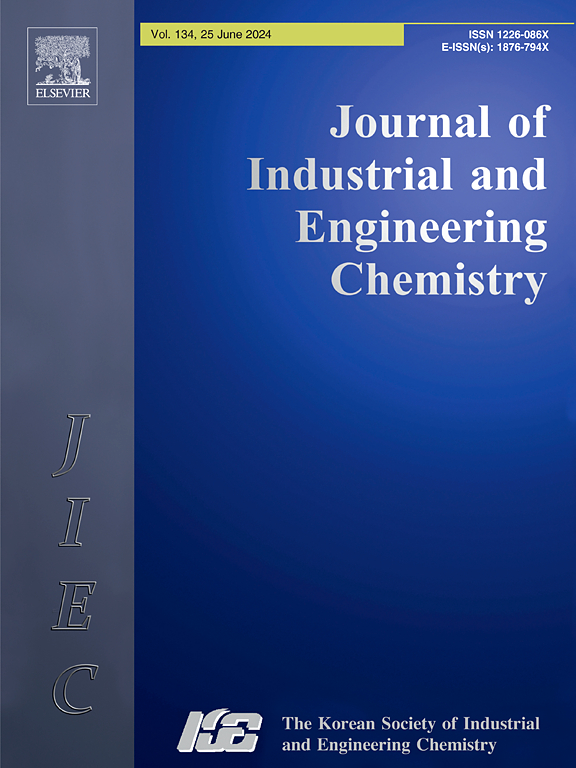Evaluation of soil property–dependent interactions of surfactant and diesel in a soil–water system
IF 5.9
3区 工程技术
Q1 CHEMISTRY, MULTIDISCIPLINARY
Journal of Industrial and Engineering Chemistry
Pub Date : 2024-11-17
DOI:10.1016/j.jiec.2024.11.033
引用次数: 0
Abstract
Experimental studies were conducted to remove hydrophobic organic compounds (HOCs) from diesel fuel-contaminated soil. Interactions between non-ionic surfactants and diesel fuel were investigated to understand the partitioning effect in heterogeneous soil–water-surfactant systems. The effective critical micellar concentration (CMCeff) was identified from surfactant adsorption, which led to the maximum partitioning of HOCs in the system. This partitioning was attributed to the surfactant (i) lowering the interfacial tension between HOC and soil, (ii) solubilizing HOCs, and (iii) mobilizing HOCs from a solid phase to a pseudo-aqueous phase. The strong adsorption capacity of clay in the soil led to an increase of CMCeff from 20 to 2,500 mg/L of Tween 80. The data for surfactant adsorption and desorption on the soil followed Freundlich’s isotherm and showed irreversible adsorption for surfactant, especially in the presence of clay. The diesel migration from soils to the aqueous phase of surfactant was observed beyond its derived CMC value. The maximum removal efficiency of HOCs could be reached at CMCeff of surfactant due to the higher solubility and competitive adsorption in the presence of clay. Understanding of the soil-surfactant-diesel behavior helped in the effective field implementation of surfactant-enhanced soil flushing for the remediation of oil-contaminated soil.

土壤-水系统中表面活性剂与柴油相互作用的评价
为清除柴油污染土壤中的疏水有机化合物(HOCs),进行了实验研究。研究了非离子表面活性剂与柴油之间的相互作用,以了解异质土壤-水-表面活性剂系统中的分配效应。通过表面活性剂的吸附作用确定了有效临界胶束浓度(CMCeff),该浓度导致系统中 HOCs 的最大分区。这种分区归因于表面活性剂:(i) 降低了 HOC 与土壤之间的界面张力;(ii) 增溶了 HOC;(iii) 将 HOC 从固相移动到了假水相。土壤中粘土的强大吸附能力导致吐温 80 的 CMCeff 从 20 毫克/升增加到 2,500 毫克/升。表面活性剂在土壤中的吸附和解吸数据遵循 Freundlich 等温线,表明表面活性剂的吸附是不可逆的,尤其是在有粘土存在的情况下。柴油从土壤向表面活性剂水相的迁移超过了表面活性剂的 CMC 值。由于表面活性剂的溶解度较高,且在有粘土存在时会产生竞争性吸附,因此在表面活性剂的 CMCeff 值时,HOCs 的去除效率最高。对土壤-表面活性剂-柴油行为的了解有助于有效地实地实施表面活性剂强化土壤冲洗,以修复受石油污染的土壤。
本文章由计算机程序翻译,如有差异,请以英文原文为准。
求助全文
约1分钟内获得全文
求助全文
来源期刊
CiteScore
10.40
自引率
6.60%
发文量
639
审稿时长
29 days
期刊介绍:
Journal of Industrial and Engineering Chemistry is published monthly in English by the Korean Society of Industrial and Engineering Chemistry. JIEC brings together multidisciplinary interests in one journal and is to disseminate information on all aspects of research and development in industrial and engineering chemistry. Contributions in the form of research articles, short communications, notes and reviews are considered for publication. The editors welcome original contributions that have not been and are not to be published elsewhere. Instruction to authors and a manuscript submissions form are printed at the end of each issue. Bulk reprints of individual articles can be ordered. This publication is partially supported by Korea Research Foundation and the Korean Federation of Science and Technology Societies.

 求助内容:
求助内容: 应助结果提醒方式:
应助结果提醒方式:


